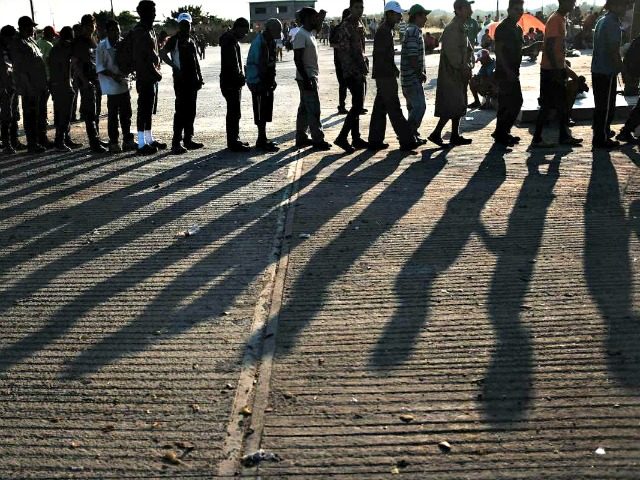The Chinese coronavirus has brought unemployment to about ten million Americans in just three weeks. In past times of unemployment, such depressions have been met with record low legal immigration levels.
United States unemployment may reach 20 percent with 25 million jobs eliminated, JPMorgan economists predict, in the coming months as states issue stay-at-home orders that have forced mass layoffs and business closures.
At the same time, the U.S. has yet to lower legal immigration levels wherein about 1.2 million legal immigrants are awarded green cards every year. At current legal immigration rates, the U.S. will likely issue over a million green cards this year.
Previous times of high unemployment have been met with spiraling legal immigration levels. During the Great Depression throughout the 1930s, when unemployment hit nearly 25 percent, legal immigration shot down dramatically as millions were laid off.
Between 1920 to 1928, legal immigration admissions floated between 300,000 to more than 805,000 annually. In 1929, legal immigration admissions dipped into free fall with less than 280,000 admissions — the lowest annual level of immigration since 1919, when only about 141,000 legal immigrants were admitted to the U.S.
While the Great Depression left millions unemployed, between the late 1920s and through the 1930s, legal immigration levels went from 241,700 admissions in 1930 to century-low of 23,068 admissions in 1933 — the lowest annual level of immigration to the U.S. since 1831, when about 22,000 legal immigrants arrived.
For nearly 15 years, between 1931 and 1945, the U.S. stabilized its legal immigration admissions below 100,000 a year. By 1946, the U.S. had started admitting about 108,000 legal immigrants, and for the next 20 years, from 1947 to 1967, annual admissions did not exceed 400,000.
In fact, legal immigration during those 20 years stayed mostly below 330,000 annual admissions and did not tick up to more than 360,000 admissions until 1967 — two years after the Hart-Celler Immigration Act of 1965 was signed into law by then-President Lyndon B. Johnson.
Since Johnson Hart-Celler, and President George H.W. Bush’s expansion of immigration in the 1990s, U.S. legal immigration admissions have averaged more than a million a year. Not since 1987 have annual legal immigration admissions dipped below 600,000, and 2013 was the last year annual admissions dropped below a million.
Polls and surveys have exhibited a longing for less immigration. The latest Harvard/Harris Poll found that about five-in-six Americans, or 83 percent, want to end all immigration from Mexico — one of the largest immigration-sending countries.
Rasmussen Reports releases weekly surveys on immigration issues. The latest findings, a survey conducted March 29 to April 2 of 1,250 likely voters, reveals decreasing overall immigration remains more popular among Americans than increasing or keeping immigration levels the same.
For example, a 47 percent plurality of Americans want legal immigration cut — including 32 percent who want less than 500,000 annual admissions. Working class Americans with no college education, those most likely to be forced to compete against foreign workers, are the most supportive of cutting annual legal immigration admissions down to below half a million.
The Rasmussen survey also finds that more than six-in-ten Americans say it is better that businesses raise wages to recruit American workers than to import foreign workers. Another 57 percent of Americans say the country already has enough talented people to take high-salary white-collar jobs and does not need more so-called “high-skilled” foreign workers.
Currently, the State Department has halted routine visa services at its embassies and consulates overseas. The agency, though, has said their goal is to return to standard visa services “as soon as possible,” but are unable to provide a specific date at this time.”
Despite mass unemployment, annual legal immigration admissions are expected to continue hovering around more than a million in 2020, unless President Trump’s administration executively halts most immigration to keep Americans from competing for scarce work against foreign nationals.
In June 2018, the U.S. Supreme Court reaffirmed the president’s control over legal immigration. In Trump v. Hawaii, the court stated that presidents have extraordinarily broad discretion to admit or exclude foreign nationals from the U.S. when they believe doing so is in the national interest.
John Binder is a reporter for Breitbart News. Follow him on Twitter at @JxhnBinder.

COMMENTS
Please let us know if you're having issues with commenting.